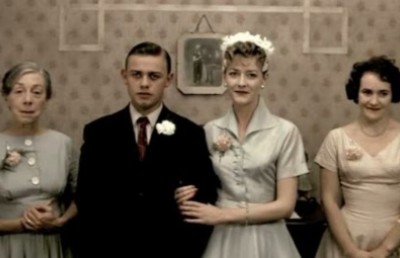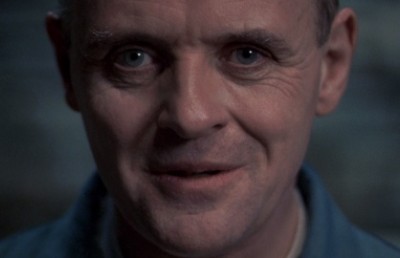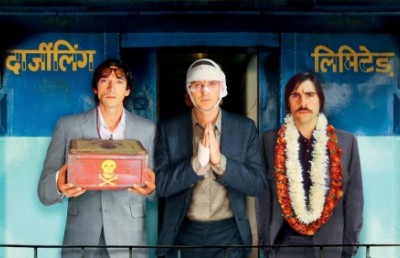The pleasures of the Genre: the Falcon films
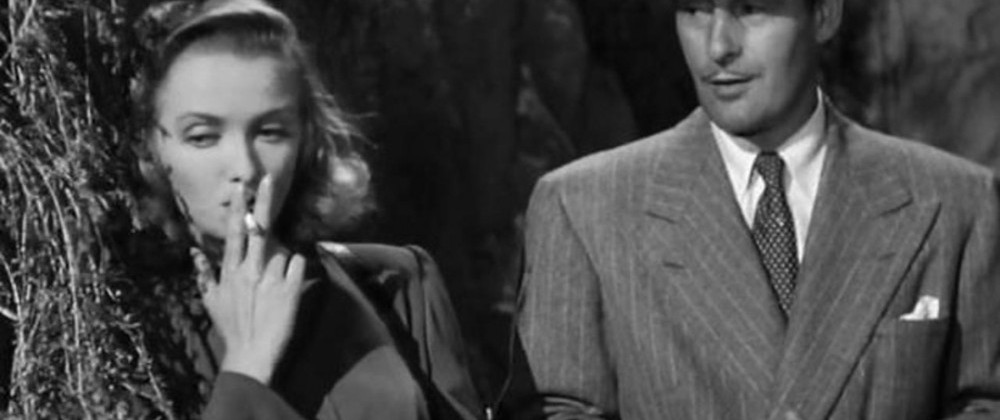
Writers on genre may be divided into pragmatists such as Stuart Fischoff (1998) who go along with accepted definitions because these suit their purposes and theoreticians such as Rick Altman who probe the structure and functions of genres. Both schools are open to criticism, pragmatists for their uncritical acceptance and theorists for intellectualising the obvious. As Altman (1984: 6) puts it in self-deprecating fashion, ‘We all know a genre when we see one. Scratch only where it itches.’ This has not deterred him from continuing to scratch. More recently, hybrid cinema has attracted interest from commentators including Jaffe (2008), though film-makers have been mixing genres for years. What can be overlooked is how audiences enjoy the results. A crime story morphs into a Shakespearian comedy of mistaken identities in Some Like It Hot (Billy Wilder, US, 1959), Vikings battle an alien in Outlander (Howard McCain, US/Germany, 2009) (Gant 2009), while Blazing Saddles (Gene Wilder, US, 1974) encapsulates contemporary attitudes to race within the genre of the Western, which it subverts in the final frames. A more subtle example is The Cook, the Thief, his Wife and her Lover (Peter Greenaway, GB/France, 1989), which has the mise-en-scène of a low-life crime drama, but without the expected vernacular, creating a stylistic disjunction which helps to shift the film into the art-house category. The Artist (Michel Hazanavicius, France/Belgium/US, 2011) adopts the acting style of a silent film, but the audience remains aware that this is a modern take on an old theme with music in Dolby sound. And what is to be made of Shakespeare in Love (John Madden, US, 1998)?
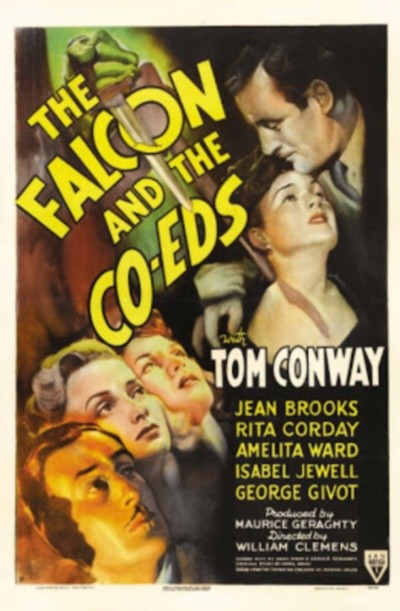
Makers of film franchises share with their colleagues producing comedy and detective series for television the problem of how to introduce enough variety to maintain audiences’ interest, while retaining tropes which offer them a sense of familiarity and help to generate loyalty. One solution is to transplant the characters to a different location, so that every comedy series has its episode set in a holiday resort. Another strategy is to stray into other genres, though the characters’ attitudes and responses remain recognisable. The distinctively British Carry on series began with Carry on Sergeant (Gerald Thomas, GB. 1958), a story of service life. The comedy became broader as the series progressed, guying such institutions as the hospital and the police as well as venturing into the Wild West, the jungle and assorted historical settings before expiring with Carry on Emmannuelle (Gerald Thomas, GB, 1978), a comic take on the Emmannuelle sexploitation films popular at the time. A change of personnel can produce a genre shift, so that when Roger Moore took on the mantle of James Bond, the series became more comedic and knowing by comparison with the Cold War thriller From Russia with Love (Terence Young, GB, 1963) with its limited repertoire of black comedy.
This playful attitude to genre is exemplified in the Falcon films from the 1940s. Leslie Charteris’s character the Saint was used by RKO as the basis for a series of films starring George Sanders. When the rights to the Saint became prohibitive, the studio turned to the Falcon as a substitute. Although Michael Arlen receives credit for the character in the films, Kevin Barton Smith (1998-2014) uncovers a more complex picture of a composite character concocted from the works of Arlen and Drexel Drake. Both the Saint and the Falcon were suave English adventurers with their own moral codes, which meant that they righted wrongs with cursory regard for the police or the law. Neither man could resist a damsel in distress. The similarities went further, with George Sanders playing both characters and Wendy Barrie appearing as his girlfriend in both series. It is not surprising that Charteris sued RKO for plagiarism, the case being settled out of court (Young and Young 2010: 244). The distinction between characters and actors became even more blurred when Sanders tired of playing Gay Lawrence alias the Falcon after three films. On screen this is explained by his brother Tom taking on the task of fighting crime and assuming the soubriquet of the Falcon. His brother was played by Tom Conway, who was Sander’s younger brother. Conway lacked Sanders’ distain and seemed happy to underplay the character. He introduced more humour into the role and though he could appear bemused, there was never any doubt about his resolve. Both the Saint and the Falcon were reincarnated for radio and television with different actors.
The Falcon operates in a variety of locations including New York, Mexico and Hollywood, which distinguishes him from private eyes who generally keep to the mean streets. In The Falcon and the Co-Eds (William Clemens, US 1943), Tom Lawrence (Tom Conway), alias the Falcon investigates the death of a professor at the exclusive Bluecliff College. In the opening scene, a girl is seen stealing out of Bluecliff Seminary to telephone for help from the Falcon. Why the college is called a seminary and why a co-educational college should only have female pupils are mysteries which never trouble the Falcon. The ostensible format is that of the private eye movie, with the Falcon encountering his usual police rivals Inspector Donovan and Detective Bates (Cliff Clark and Edward Bargan) and outwitting them to comic effect. Philip Marlowe never proved so irresistible to girls, though the Falcon manages not to fall for their charms. This steers the film away from settling into a romance, which must have been a relief to audiences expecting a crime story. The Falcon’s visit coincides with the college’s festival, which provides an excuse for a scene of rehearsal tantrums as well as musical numbers performed at the festival. Musical interludes were common in low budget films of the time from the Mancunian comedies in Britain to the Dean Martin and Jerry Lewis comedies in America. Songs can slow down the proceedings, but in The Falcon and the Co-Eds the theatrical setting is used to demonstrate the hypersensitive character of Marguerita Serena (Rita Corday), who refuses to handle the foil intended for the fencing display.
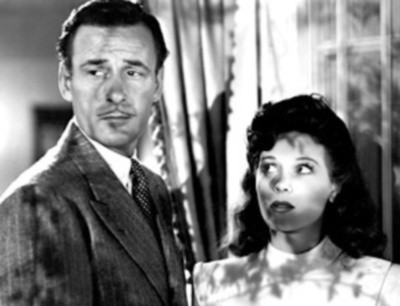
The Falcon with Marguerita (Rita Corday)
Marguerita is a student at the college. She is considered by the other girls to be psychic, foretelling the murder of the professor. Now she predicts the murder of the headmistress Miss Keys (Barbara Brown). Though Marguerita may not be able to see into the future, she does notice tensions between the staff. She becomes a suspect when she finds Miss Keys’ body, while the foil she refused to handle is nearby and is the probable murder weapon. Afterwards, the Falcon finds her listening to a recording of a romantic piano concerto. It was composed by her father, who committed suicide. She calls herself abnormal and the sound of the wind in the trees echoes this, almost seeming to be a distorted voice. The Falcon is down to earth, telling her to ‘Stop it, Marguerita—you’re letting your imagination get the better of you.’ Later she wonders whether she might be the killer: ‘Maybe I am insane.’
The Falcon and the Co-Eds is an example of how Freudian theories were becoming popularised. The overwrought Marguerita and the doctor-cum-psychologist Dr Graelich (George Givot) were character types which were to become familiar to audiences when the sub-genre got into its stride with Madonna of the Seven Moons (Arthur Crabtree, GB, 1944), The Seventh Veil (Compton Bennett, GB, 1945) and Spellbound (Alfred Hitchcock, US, 1945). The Falcon film also illustrates how overwrought emotions could be expressed in romantic piano music. The Warsaw Concerto composed for Dangerous Moonlight (Brian Desmond Hurst, GB, 1941) set a precedent which Love Story (Leslie Arliss, GB, 1944) and The Seventh Veil followed enthusiastically, the trend reaching its apotheosis in Brief Encounter (David Lean, GB, 1945).
Dr Graelich is first seen lecturing to the girls on evolution. His accent places his origins as somewhere in middle Europe and, as so often in films, this is enough to make him a suspect, particularly as he certified that the professor died of heart failure. Also a suspect is Miss Gaines (Jean Brooks), the teacher who tried to make Marguerita hold the foil at the festival rehearsal. The film’s credentials as a whodunit are clear. The doctor admits that he went along with Miss Keys’ wish not to involve the school in adverse publicity and concealed the professor’s suicide. After forcing the coroner to reveal that death was the result of a massive drug overdose, the Falcon comes to suspect that the suicide story is also a lie. The rivalry between the professor and the doctor for Miss Gaines’s affections does not concern him. He is more interested in a framed photograph of the doctor and Miss Gaines. Questioning reveals that the doctor is married, but he kept it secret because Miss Keyes would not allow married teachers in the college. Miss Gaines agrees that the doctor wanted to marry her as a way of being allowed to stay in America, but she turned him down. Further probing leads to his wife being unmasked as the music teacher Miss Phoebus (Isabel Jewell), who was willing to go through with a marriage of convenience for her love of the doctor. Her mind was turned when she realised his interest in Miss Gaines. Miss Phoebus killed the professor with the intention of incriminating the couple in his death, killing Miss Keys when she attempted to conceal what had happened. With the mystery resolved, the doctor and Miss Gaines can be brought into the Falcon’s band of allies for the denouement. Marguerita teeters on the edge of the cliff, being egged on by Miss Phoebus and with the distorted voice echoing, ‘The sea. Only one answer. The sea.’ Images of waves crashing over rocks throughout the film lead to this moment. Rebecca (Alfred Hitchcock, US, 1940) must have been fresh in the film-makers’ minds. It is the villainess who overbalances and falls to her death as right triumphs and Marguerita clings to the Falcon.
In a running time of 65 minutes, the film-makers include a satisfying mix of crime, action, romance, music, comedy and melodrama. There is little time for character development—the doctor and his marriage could have been the subject of a film, as could the sexual pressure cooker of Bluecliff College—but the story is tied up neatly. One genre which is not included is the Western, but the next in the series, The Falcon out West (William Clemens, US, 1944), made good this omission.
At a New York party to celebrate Tex’s second marriage, the host is killed, apparently by a rattlesnake bite. The prime suspect is the host’s fiancée Vanessa Drake (Carole Gallagher, credited as Carole Galagher on the poster), whom the Falcon agrees to help. He accompanies her to Tex’s ranch, where the late host indulged his fantasy of living in the Wild West. The tradition continues, with a stage coach collecting visitors from the station. Among them are the Falcon’s old sparring partners Inspector Donovan and Detective Bates. To add verisimilitude, the coach is attacked by ‘gunmen’. What is not planned is that the horses bolt. In typical Western fashion, a rider on a rocky outcrop sees the runaway coach and intercepts it, bringing it to a halt. The rescuer is Marion Colby (Barbara Hale) the daughter of Tex’s business partner. The Falcon finds a bullet hole in the coach: one of the gunmen was shooting for real.
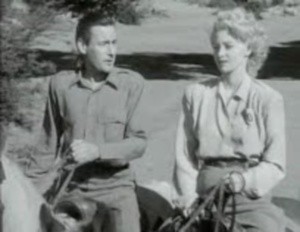
The Falcon rides with Vanessa (Carole Gallagher)
This is a whodunit which soon takes on the trappings of the Western. The West in this case might be a rich man’s indulgence, but it has all the tropes. The locations are authentic and there are plenty of chases on horseback across scrubland, not to mention cowboys toting guns. There are even some Native Americans in costume who act as servants at the ranch. This creates a sense of post-modern irony as we watch a film which is played with a knowing wink to the audience by Tom Conway, while within it is a parody of the cinematic Wild West which the Native Americans treat with justified distain. Inside the ranch house, the tropes of the Western fall away—even rich Texans recreating the Wild West expect electric lights—and we are back in the world of the whodunit as Tex’s attorney is killed in the same way as his late client. Is the killer Marion, her father who owned the two-pronged ring which simulated a rattlesnake bite, or the fiancée, Vanessa, who was apparently given the ranch as a wedding present by Tex? Other candidates are his former wife (Joan Barclay), who has come to keep an eye on Vanessa, and the Native Americans who have their own way of life harking back to their cultural roots, taking off as a group whenever they want and despising the interlopers. Inevitably the Falcon pre-empts the police in solving the crime after displaying his expert horsemanship and getting into a few scrapes. The denouement is more action movie than Agatha Christie as Vanessa and her secret lover, the hired hand Dusty, try to make their getaway with the Falcon as hostage. A femme fatale and her sidekick prove no match for the wily adventurer. At the end of the film when the assembled company returns to the railway station, there is the trademark scene in which the Falcon gets into the train with a beautiful girl who implores him to help her. Another adventure is in the offing.
Like other studios, RKO had its roster of starlets; seeing them in contrasting roles is an incidental pleasure of the series. Barbara Hale was to appear in The Falcon in Hollywood (Gordon Douglas, US, 1944), while Carole Gallagher, Patti Brill and Mary Halsey were pupils at Bluecliff College who can also be seen in The Falcon out West. Crucially the Falcon films offer audiences the familiarity of characters and format. As with soaps, we know in outline what is going to happen because we know the people and we would be disconcerted if familiar characters were missing, or events lurched in an unexpected direction. The only moment in the series when expectations might have been jolted came when George Sanders bowed out and Tom Conway took over in The Falcon’s Brother (Stanley Logan, US, 1942), where the plotline to cover the changeover is contrived. Alongside familiarity came sufficient variation to keep audiences interested. The Saint visited a variety of locations, but the Falcon’s scriptwriters found more variation in genre as well as locale, flirting with the school story, the Western and the holiday romance, not to mention the child-centred The Falcon in San Francisco (Joseph H. Lewis, US, 1945) and the very process of film-making in The Falcon in Hollywood. The films were generally closer to whodunits than the action comedies of the Saint series, with the third film, The Falcon Takes Over (Irving Reiss, US, 1942), being the first screen adaptation of Raymond Chandler’s Farewell, My Lovely. They had no pretensions to be anything other than undemanding B-movies, but they succeeded in this objective. They are well crafted and remain entertaining, thanks in no small measure to the games they play with genres.
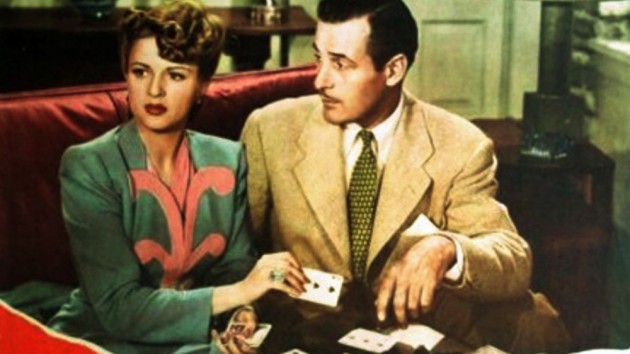
Bibliography
Altman, Rick (1984), ‘A Semantic/Syntactic Approach to Film Genre’, Cinema Journal, 23/3: 6-18, http://www.jstor.org/stable/1225093 accessed 6 January 2015.
Fischoff, Stuart, Antonio, Joe and Lewis, Diane (1998), ‘Favorite Films and Film Genres as a Function of Race, Age, and Gender’, (Paper originally presented at American Psychological Association Convention, Chicago, August, 1997), Journal of Media Psychology, 3/1, http://web.calstatela.edu/faculty/sfischo/media3.html accessed 6 January 2015.
Gant, Charles (2009), ‘Mash up: how mixing and matching genres can pay’, Guardian, 22 March 2009.
Jaffe, Ira (2008), Hollywood Hybrids: mixing genres in contemporary films, (Lanham, MD: Rowman and Littlefield).
Smith, Kevin Barton (1998-2014), The Thrilling Detective Web Site, http://www.thrillingdetective.com/falcon.html accessed 6 January 2015.
Young, William H. and Young, Nancy K. (2010), World War II and the Postwar Years in America: a historical and cultural encyclopedia, (Santa Barbara, CA: ABC-CLIO).


